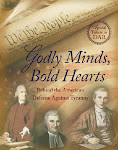There really was a man referred to as Johnny Appleseed who walked barefoot some 100,000 square miles in the 1800's to plant apple trees. He lived simply and sacrificially as a believer in God, worked for the sake of his fellow human beings, and strived to be in harmony with nature. He became an American legend while still alive and is today a symbol of the America pioneer spirit, fresh and hopeful.
Born John Chapman (1774–1847) in Leominster, Massachusetts, as the second child of Nathaniel and Elizabeth Chapman, he was a direct descendant of Edward Chapman. Edward Chapman came from Yorkshire, England, to Boston in the 1640s and earned his way through hardships to become a successful farmer and miller in Ipswich.
John's father, who fought at Concord as a Minuteman in 1775 and later served in the Continental Army with General George Washington during the American Revolutionary War, was away from home when Johnny was born. That was around the time that the battle of Bunker Hill was fought. He was an officer leading a company of carpenters attached to General George Washington's forces in New York City.
While Nathaniel was in military service, his wife died shortly after giving birth to a second son. The baby also died a few days after his mother. After Nathaniel Chapman ended his military service, he returned home to Springfield, Massachusetts, and later married again in 1780 to Lucy Cooley of Longmeadow, Massachusetts. They had 10 children.
Though there is no deed found of the farms that they owned, tradition tells us that they lost most of what they had during the American Revolution. They maintained a small farm with an apple orchard where Johnny Chapman liked to run and play. As settlers stopped by, he learned of wilderness lands that were being developed through toil and risk of death through starvation. He believed apples could provide an answer, that everyone could someday be nourished by their hardy goodness. As he grew, he understood just how practical and valuable his boyhood dream would be.
In 1792, Johnny Chapman went west toward the Susquehanna River, starting on a life's mission to bring needed sustenance and help to new settlers. He got his start by picking out seeds from apple pulp thrown away by cider mills and then planting the seeds in undeveloped areas, continuing on through Ohio, Indiana, and Illinois.
The apples sown by Chapman were not like today's familiar sweet and tart fruit, which has evolved through grafting clones. The trees he started from seeds were not dependable but instead varied from tree to tree to produce a small, sour snack. Still, the trees did indeed save many lives and provided vital vitamins and fiber to a frontier diet heavy in game meat.
Apples could be stored in a root cellar for months. If dried, the sections were used to flavor pork, soups, and stews. The juice could be made into hard cider which served well when water was scarce or its quality questionable. Since apples filled a great need in the diets of early pioneers, generations of settlers were grateful to him for providing food as well as a livelihood.
Chapman owned orchards by finding land and paying for it with the promise of apple trees. He would clear the land, start a nursery with seeds he got for free from cider mills, and then give instructions to a nearby settler to care for the nursery and sell the trees for part share. He told the new managers they could sell trees on credit to settlers that were just starting to lay roots in the area. Then Johnny would be off to his next destination.
As trees transplanted from Chapman's orchards began to flourish, wild apple trees began to appear. Wildlife finding stray apples would deposit some of the seeds they ingested into various parts of the wilderness. These wild apple trees would combine with trees from Johnny's orchards to produce stronger apple trees. Many new varieties occurred from which many of our heirloom apples today have evolved.
A few years after Johnny first started his journey, the Continental Congress had ratified resolutions to donate public lands to those who had left Canada and Nova Scotia to fight the British in the Revolutionary War. Upon hearing that grants of land were awarded and with an eye to future markets, Johnny got busy transporting seeds to the area. He carried sixteen bushels of apple seeds down the Ohio River with two canoes lashed together. He planted tree orchards for the war veterans before they got there, surprising them with fruit trees ready to buy at modest cost by the time they were settled. Many towns have risen on or near his nursery sites.
Most of his time was spent traveling from home to home on the frontier. Though dressed very poorly, he was welcome at many a table in many a home. He often found people that needed help, and they would offer supper and shelter for the night. Before sitting down to eat a meal with a family, it is said he always made sure the children had enough to eat first.
The beliefs and kindness of Johnny 'Appleseed' Chapman
As a missionary for the Church of the New Jerusalem, he spread the Swedenborgian gospel by explaining doctrine to the adults and telling stories to the children. He would tear a few pages from one of Swedenborg's books and leave them with his hosts.
The Church of the New Jerusalem is a Christian church based on the biblical interpretations of Emanuel Swedenborg. Swedenborg was a Swedish scientist, investor, and theologian. Though some of his beliefs were mystical, Johnny 'Appleseed' Chapman took the Bible to heart and lived his life according to the Scriptures. He was truly a gentle, kind, helpful man.
He did not drink alcohol nor did he eat meat, as he could not stand the thought of hurting animals. If he saw an animal being mistreated, he would buy the animal and find a new home for it. When he heard a horse was to be put down, he would buy the horse, then buy acres of grass, and turn the horse out on the grass to live out his days in peace. Sometimes he would give the horse away to someone needy if they promised to treat it humanely.
Chapman made friends with many of the Indian tribes and was known to have learned many Indian languages well enough to converse. Memoirs from settlers in the area show that many Indians were in awe of him, and some believed he was touched by the Great Spirit because of his passion for serving others. Because of that high regard they held for him, they allowed him to listen to their council meetings. As a result, he was sometimes able to avert trouble between a tribe and incoming settlers.
During the war of 1812 the British and the Indians were roaming the country killing the settlers. Unselfishly, Johnny traveled many days and nights without food or rest to save lives by going from house to house warning the people to take shelter and try to protect themselves.
His later years and death
Johnny made several trips east to visit his sister and also to replenish his supply of Swedenborgian literature. He typically would visit his orchards every year or two to collect his earnings of about six cents per tree. The money was used to plant more orchards, or he gave it away to someone who was in need. The majority of earnings during his lifetime were given to his sister, to his church, and to various needy people he came upon.
If someone couldn't pay, he would barter for used clothing or corn meal, or he gave the trees away without cost or told them they could pay him later.
Upon his death, he left an estate of over 1,200 acres of valuable nurseries to his sister. He was actually worth much more, but unfortunate occurrences prevented that from being shown.
The financial panic of 1837 took a toll on his estate. Trees only brought two or three cents each. Some of his land was sold for taxes following his death, and litigation used up much of the rest. He had purchased the southwest quarter (160 acres) of section 26, Mohican Township, Ashland County, Ohio, but he did not record the deed and lost the property.
Historical documents say he was buried beneath an apple tree along the St. Joseph River, on the Archer farm, "four miles north of Fort Wayne." Although the actual site of his grave is disputed, a national historic landmark gravesite is located in Johnny Appleseed Park (formerly known as Archer Park) in Fort Wayne, Indiana.
An incident that lives on in American memory
--"One day a preacher came to the area where Johnny was working and in his sermon decried materialism asking, 'Where now is there a man who like the primitive Christian is traveling to heaven barefooted and in coarse raiment?' After he had made the statement several times, John in his coffee-sack shirt stepped forward and said, 'Here's your primitive Christian.' The preacher quickly dismissed the congregation."--
In Memory of Johnny Appleseed
Johnny Appleseed Song American popular culture remembers the Johnny Appleseed traveling song, "The Lord is good to me,' which is today sung in camps or before meals in some American households.
Oh, the Lord's been good to me, And so I'll thank the Lord For giving me the things I need, The sun and the rain and the appleseed, The Lord's been good to me. Amen Amen Amen Amen Amen, Aaaaaaaaaamen.
And every seed I sow, will grow up to a tree, And we'll have apples everywhere, For you and me and the world to share, The Lord's been good to me. Amen… amen, amen, amen, Aaaaaaaaaamen.
In honor of Johnny Appleseed, Fort Wayne, Indiana holds an annual festival, as does Sheffield, Pennsylvania, and Crystal Lake, Illinois.
Johnny Appleseed School is in Leominster, Massachusetts.
Statue of Johnny Appleseed
Viktor Schreckengost's sculpture of Johnny Appleseed kneeling above the doors of the Lakewood High School Civic Auditorium in Lakewood, Ohio, has been the source of some controversy. Used as a logo for the Lakewood Schools ever since its inception, the local Board of Education decided that progress would be served if the statue was generic, if it was simply called 'Early Settler.' While the Board calls Appleseed 'eccentric,' ignores the intent of the artist, and tries to diminish the memory of a true legend, everyday Americans still refer to the statue by its intended name of 'Johnny Appleseed.'
Disney honored Johnny Appleseed with animated 1948 film
Melody Time featured Dennis Day in a fantasy tale based on the life of Johnny Appleseed. It is a 19-minute segment about an apple farmer who sees others going west, wistfully wishing he, too, could find purpose in going west. An angel appears, singing an apple song, and gives Johnny encouragement to fulfill his dream.






























































































No comments:
Post a Comment